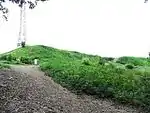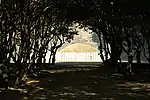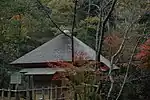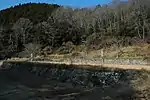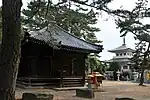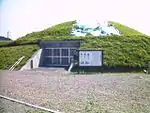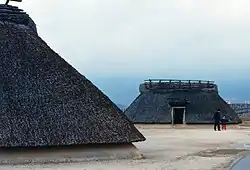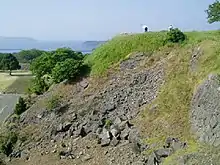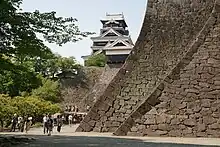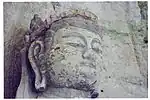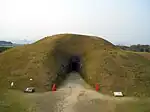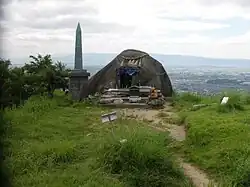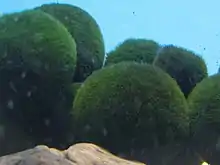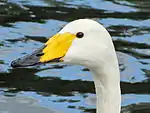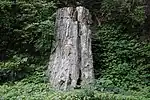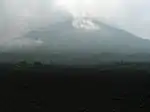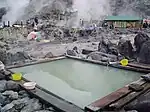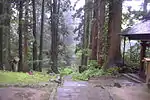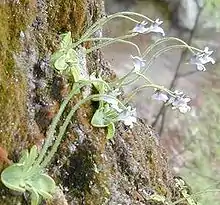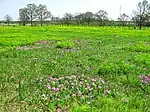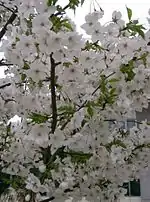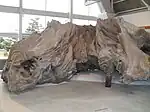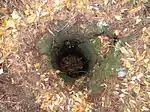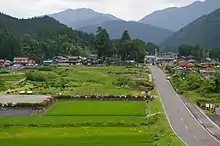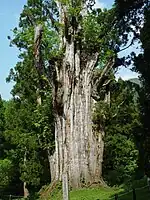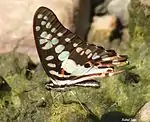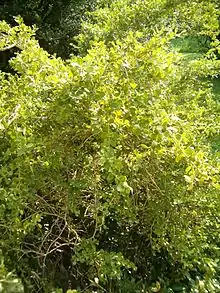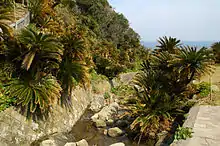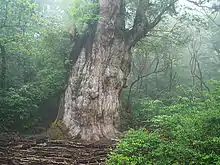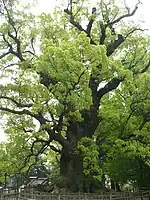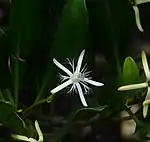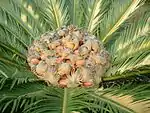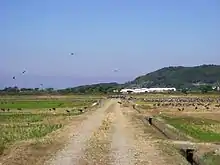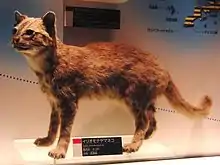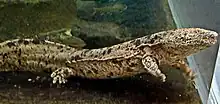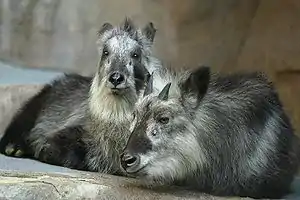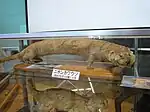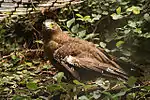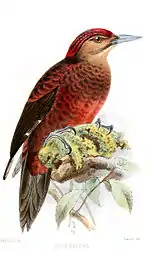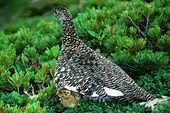To protect Japan's cultural heritage, the country's government selects through the Agency for Cultural Affairs important items and designates them as Cultural Properties under the Law for the Protection of Cultural Properties. Designated items are classified in a number of categories, one of which is Monuments (記念物, kinenbutsu). This category includes historic locations such as shell mounds, ancient tombs, sites of palaces, sites of forts or castles, monumental dwelling houses and other sites of high historical or scientific value; gardens, bridges, gorges, mountains, and other places of great scenic beauty; and natural features such as animals, plants, and geological or mineral formations of high scientific value.[1][2]
The government further designates "significant" monuments classifying them in three categories: Historic Sites (史跡, shiseki), Places of Scenic Beauty (名勝, meishō), and Natural Monuments (天然記念物, tennen kinenbutsu). Items of particularly high significance receive higher classifications: Special Historic Sites (特別史跡, tokubetsu shiseki), Special Places of Scenic Beauty (特別名勝, tokubetsu meishō), and Special Natural Monuments (特別天然記念物, tokubetsu tennen kinenbutsu) respectively. As of October 24, 2023 there are 1,040 Natural Monuments, 1895 Historic Sites, 429 Places of Scenic Beauty, 75 Special Natural Monuments, 36 Special Places of Scenic Beauty and 63 Special Historic Sites.[3]
Since a single item can fall under more than one of these categories, the total number of sites is less than the sum of designations.
Criteria
The Agency for Cultural Affairs designates monuments based on a number of criteria. A monument can be designated based on more than one of these criteria:[4]
Places of Scenic Beauty and Special Places of Scenic Beauty
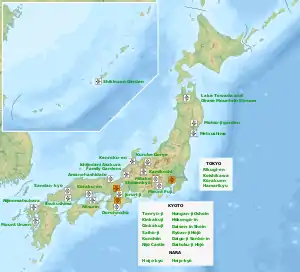
- Parks and gardens
- Bridges and embankments
- Flowering trees, flowering grass, autumn colors, green trees and other places of dense growth
- Places inhabited by birds and wild animals, fish/insects and others
- Rocks, caves
- Ravines, gorges, waterfalls, mountain streams, abysses
- Lakes, marshes, wetlands, floating islands, springs
- Sand dunes, spits, seasides, islands
- Volcanoes, onsen
- Mountains, hills, plateaus, plains, rivers
- Viewpoints
Historic Sites and Special Historic Sites
- Shell mounds, settlement ruins, kofun, other historic ruins of this type
- Ruins of fortified towns, castles, government administration offices, old battlefields and other historic ruins related to politics or government
- Remains of shrines and temples, former compound grounds and other historic ruins related to religion
- Schools, research institutions, cultural facilities and other historic ruins related to education, learning or culture
- Medical care and welfare facilities, life related institution, other society and life related historic ruins
- Transport and communication facilities, forest conservation and flood control facilities, manufacture facilities and other historic sites related to finance or manufacture activities
- Graves and stone monuments with inscriptions
- Former residences, gardens, ponds and other areas of particular historical significance
- Ruins related to foreign countries or foreigners
Natural Monuments and Special Natural Monuments
- Animals
- Well-known animals peculiar to Japan and their habitat
- Animals which are not peculiar to Japan, but need to be preserved as well-known characteristic Japanese animals, and their habitat
- Animals or animal groups peculiar to Japan within their natural environment
- Domestic animals peculiar to Japan
- Well-known imported animals presently in a wild state, with the exception of domestic animals; their habitat
- Particularly valuable animal specimen
- Plants, vegetation
- Old trees of historic interest, gigantic trees, old trees, deformed trees, cultivated pulpwood, roadside trees, shrine forests
- Representative primeval forests, rare forest flora
- Representative alpine plants, special clusters of plants on rock ground
- Representative clusters of waste land plants
- Representative examples of coastal and sand ground vegetation
- Representative examples of areas of peat forming plants
- Clusters of plants growing in caves or grottoes
- Rare water plants in garden ponds, onsen, lakes, marshes, streams, sea, etc.; algae, moss, microbes, etc.
- Remarkable occurrence of epiphytic plants on rocks, trees or shrubs
- Remarkable plant growth on marginal land
- Remarkable growth in the wild of crop plants
- Wild habitat of rare or near extinct plants
- Geological and mineralogical features
- Rocks, mineral and fossil producing sites
- Conformable and unconformable strata
- Fold and thrust strata
- Geological features caused by the work of living creatures
- Phenomena related to earthquake dislocation and landmass motion
- Caves, grottoes
- Examples of rock organization
- Onsen and their sediments
- Erosion and weathering related phenomena
- Fumaroles and other items related to volcanic activity
- Ice and frost related phenomena
- Particularly precious rock, mineral and fossil specimen
- Representative territories rich in natural monuments to be protected (Natural Protected Areas)
Usage
The table's columns (except for Remarks and Photo) are sortable pressing the arrows symbols. The following gives an overview of what is included in the table and how the sorting works.
- Name: name of the monument as registered in the Database of Cultural Properties
- Special Place of Scenic Beauty: criteria under which the monument has been designated or "-" if it is not a Special Place of Scenic Beauty
- Special Historic Site: criteria under which the monument has been designated or "-" if it is not a Special Historic Site
- Special Natural Monument: criteria under which the monument has been designated or "-" if it is not a Special Natural Monument
- Remarks: general remarks
- Location: "town-name prefecture-name" and geo coordinates of the monument if applicable
- sorts as "prefecture-name town-name"
- Photo: picture of the monument
Special Places of Scenic Beauty, Special Historic Sites, Special Natural Monuments
References
- ↑ "Cultural Properties for Future Generations" (PDF). Administration of Cultural Affairs in Japan ― Fiscal 2009. Agency for Cultural Affairs. June 2007. Archived from the original (PDF) on 2009-03-27.
- ↑ "Preservation and Utilization of Cultural Properties" (PDF). Administration of Cultural Affairs in Japan ― Fiscal 2009. Agency for Cultural Affairs. 2009. Archived from the original (PDF) on 2007-11-10.
- ↑ 史跡等の指定等について [Designation of Historic Sites] (PDF). Agency for Cultural Affairs. 2023-10-24. Retrieved 2022-12-17.
- ↑ 昭和二十六年文化財保護委員会告示第二号(国宝及び重要文化財指定基準並びに特別史跡名勝天然記念物及び史跡名勝天然記念物指定基準) [Bulletin of the Association for the rehabilitation of cultural properties, number 2 from 1951 (Designation criteria for National Treasures, Important Cultural Properties, Special Historic Sites, Places of Scenic Beauty, Natural Monuments)] (in Japanese). Tokyo: MEXT. Archived from the original on 2018-01-11. Retrieved 2010-01-01.
- ↑ "Motsuji Temple - Special Historic Site and Special Place of Scenic Beauty". Mōtsū-ji. Archived from the original on 2010-09-14. Retrieved 2009-12-18.
- ↑ "Hama-rikyu Gardens". Tokyo Metropolitan Park Association. Archived from the original on 2016-10-29. Retrieved 2009-12-18.
- ↑ "Koishikawa Korakuen Gardens". Tokyo Metropolitan Park Association. Archived from the original on 2006-04-07. Retrieved 2009-12-18.
- ↑ "Rikugien Gardens". Tokyo Metropolitan Park Association. Archived from the original on 2014-02-04. Retrieved 2009-12-18.
- ↑ "Kenroku-en". Ishikawa Prefecture. 2003. Retrieved 2009-12-18.
- ↑ "Shōsenkyō" (in Japanese). Shosenkyo Kankoukyokai. Archived from the original on 2009-12-16. Retrieved 2009-12-18.
- ↑ "Kamikōchi". Kamikōchi. Archived from the original on 2009-10-05. Retrieved 2009-12-18.
- ↑ "Ginkaku-ji". Shōkoku-ji. Archived from the original on 2010-07-28. Retrieved 2009-12-18.
- ↑ "Kinkaku-ji". Shōkoku-ji. Archived from the original on 2010-04-30. Retrieved 2009-12-18.
- ↑ "Koke - dera". Kyoto Prefectural Government Tourism Division. Archived from the original on 2010-03-08. Retrieved 2009-12-18.
- ↑ "Daisen-in" (in Japanese). Daisen-in. Retrieved 2009-12-18.
- ↑ "Sanbō-in". Daigo-ji. Retrieved 2009-12-18.
- ↑ "Amanohashidate". Amanohashidate Tour Association Monju branch. Retrieved 2009-12-18.
- ↑ "Tenryū-ji". Kyoto Prefectural Government Tourism Division. Archived from the original on 2009-09-23. Retrieved 2009-12-18.
- ↑ "Gardens". Nijō Castle. Archived from the original on 2013-05-10. Retrieved 2009-12-18.
- ↑ "Garden at the Eastern Palace, Nara palace site". Japanese Garden Dictionary. Department of Cultural Heritage of the Nara National Research Institute for Cultural Properties. Archived from the original on 2011-07-19. Retrieved 2011-01-29.
- ↑ 平城京左京三条二坊宮跡庭園 (in Japanese). Nara Tourism. Archived from the original on 2010-01-30. Retrieved 2009-12-18.
- ↑ "Kōraku-en" (in Japanese). Okayama Kōraku-en. Retrieved 2009-12-18.
- ↑ "Miyajima". Miyajima Tourist Information. Retrieved 2009-12-18.
- ↑ "Ritsurin Garden". Kagawa Prefecture. Retrieved 2009-12-18.
- ↑ "Nijinomatsubara". Yokatoko. Archived from the original on 2009-06-09. Retrieved 2009-12-18.
- ↑ "Goryōkaku" (in Japanese). Agency for Cultural Affairs. Archived from the original on 2010-03-27. Retrieved 2009-12-18.
- ↑ "Sannai-Maruyama Site". Sannai-Maruyama Site. Retrieved 2009-12-18.
- ↑ 中尊寺境内 (in Japanese). Cultural Heritage Online. Archived from the original on 2011-10-07. Retrieved 2009-12-18.
- ↑ 毛越寺境内附鎮守社跡 (in Japanese). Iwate Prefecture. Retrieved 2009-12-18.
- ↑ 特別史跡多賀城跡附寺跡 (in Japanese). Tagajō city. Archived from the original on 2009-04-13. Retrieved 2009-12-18.
- ↑ 多賀城跡 附 寺跡 (in Japanese). Cultural Heritage Online. Archived from the original on 2011-10-07. Retrieved 2009-12-18.
- ↑ 大湯環状列石 (in Japanese). Ōyu Stone Circle. Archived from the original on 2002-11-06. Retrieved 2009-12-18.
- ↑ 弘道館公園 (in Japanese). Ibaraki Prefecture. Archived from the original on 2016-02-14. Retrieved 2009-12-18.
- ↑ 常陸国分寺跡 (in Japanese). Ishioka city. Archived from the original on 2011-07-19. Retrieved 2009-12-18.
- ↑ 常陸国分尼寺跡 (in Japanese). Ishioka city. Archived from the original on 2011-07-19. Retrieved 2009-12-18.
- ↑ "Cedar Avenue of Nikko". Nikko Tourist Association. Archived from the original on 2010-01-04. Retrieved 2009-12-18.
- ↑ "Cedar Avenue of Nikko". Nikkō. Archived from the original on 2009-12-11. Retrieved 2009-12-18.
- ↑ 金井沢碑 (in Japanese). Takasaki city. Archived from the original on 2011-07-20. Retrieved 2009-12-18.
- ↑ 山上碑(やまのうえひ)及び古墳 (in Japanese). Takasaki city. Archived from the original on 2011-07-20. Retrieved 2009-12-18.
- ↑ 多胡碑 (in Japanese). Takasaki city. Retrieved 2009-12-18.
- ↑ 特別史跡の新指定 [Designation of new Special Historic Sites] (PDF). Agency for Cultural Affairs. 2017-09-14. Retrieved 2017-11-18.
- ↑ 一乗谷朝倉氏遺跡 (in Japanese). Fukui city. Archived from the original on 2014-01-03. Retrieved 2009-12-18.
- ↑ 遠江国分寺跡 (in Japanese). Iwata city. Archived from the original on December 2, 2009. Retrieved 2009-12-18.
- ↑ 新居関跡 (in Japanese). Arai city. Archived from the original on 2009-12-08. Retrieved 2009-12-18.
- ↑ 新居関跡 (in Japanese). SHINEI SYSTEMS. Archived from the original on 2011-08-17. Retrieved 2009-12-18.
- ↑ 登呂遺跡 (in Japanese). Shizuoka city. Archived from the original on 2009-12-05. Retrieved 2009-12-18.
- ↑ "Museum of Motoori Norinaga" (in Japanese). Museum of Motoori Norinaga. Retrieved 2009-12-18.
- ↑ 姫路城跡 (in Japanese). Agency for Cultural Affairs. Archived from the original on 2009-02-01. Retrieved 2009-12-18.
- ↑ キトラ古墳 (in Japanese). Kashihara Archaeological Institute. Archived from the original on 2009-08-22. Retrieved 2009-12-18.
- ↑ "Takamatsuzuka Tomb" (in Japanese). Nara Prefecture. Archived from the original on 2011-03-05. Retrieved 2009-12-18.
- ↑ 山田寺跡 (in Japanese). Asuka historical Museum fanclub. Retrieved 2009-12-18.
- ↑ 石舞台古墳 (in Japanese). Nara Prefecture. Archived from the original on 2009-06-12. Retrieved 2009-12-18.
- ↑ 巣山古墳 (in Japanese). Kōryō town. Retrieved 2009-12-18.
- ↑ 藤原宮跡 (in Japanese). Kashihara city. Retrieved 2009-12-18.
- ↑ 文殊院西古墳 (in Japanese). Asuka historical Museum fanclub. Retrieved 2009-12-18.
- ↑ 平城宮跡 (in Japanese). Nara National Research Institute for Cultural Properties. Archived from the original on 2004-08-14. Retrieved 2009-12-18.
- ↑ 本薬師寺跡 (in Japanese). Kashihara. Retrieved 2009-12-18.
- ↑ 岩橋千塚古墳群 (in Japanese). Cultural Heritage Online. Archived from the original on 2011-07-23. Retrieved 2009-12-18.
- ↑ 旧閑谷学校 (in Japanese). Agency for Cultural Affairs. Retrieved 2009-12-18.
- ↑ "Shizutani School". Bizen city. Retrieved 2009-12-18.
- ↑ "廉塾ならびに菅茶山旧宅". Hiroshima. Archived from the original on 2010-06-18. Retrieved 2009-12-18.
- ↑ "Renjuku/Old Chazan Kan house". Fukuyama Tourist Information. Retrieved 2009-12-18.
- ↑ 讃岐国分寺跡 (in Japanese). Cultural Heritage Online. Archived from the original on 2011-07-23. Retrieved 2009-12-18.
- ↑ 王塚古墳 (in Japanese). Keisen. Retrieved 2009-12-18.
- ↑ 大宰府跡 (in Japanese). Agency for Cultural Affairs. Archived from the original on 2008-05-03. Retrieved 2009-12-18.
- ↑ 大野城跡 (in Japanese). Fukuoka Prefecture. Archived from the original on 2010-05-05. Retrieved 2009-12-18.
- ↑ "Yoshinogari Historical Park". Yoshinogari Historical Park. Retrieved 2009-12-18.
- ↑ 佐賀県:国指定(史跡の部) (in Japanese). Saga Prefecture. Archived from the original on 2011-07-17. Retrieved 2009-12-18.
- ↑ 金田城跡 (PDF) (in Japanese). Nagasaki Prefecture. Archived from the original (PDF) on 2011-07-16. Retrieved 2009-12-18.
- ↑ 原の辻遺跡 (in Japanese). Nagasaki Prefecture. Archived from the original on December 10, 2008. Retrieved 2009-12-18.
- ↑ 臼杵磨崖仏 附 日吉塔、嘉応二年在銘五輪塔 承安二年在銘五輪塔 (in Japanese). Agency for Cultural Affairs. Archived from the original on 2011-07-23. Retrieved 2009-12-18.
- ↑ 国宝 臼杵石仏 公式ホームページ (in Japanese). Usuki city. Archived from the original on 2009-12-08. Retrieved 2009-12-18.
- ↑ "Saitobaru Burial Mounds" (in Japanese). Saitobaru Burial Mounds. Archived from the original on 2011-05-24. Retrieved 2009-12-18.
- ↑ 基肄城跡 (in Japanese). Chikushino city. Retrieved 2009-12-18.
- ↑ 史跡等の指定等について [Designation of Historic Sites] (PDF). Agency for Cultural Affairs. 2020-11-22. Retrieved 2020-11-20.
- ↑ 鯛の浦タイ生息地 (in Japanese). Kamogawa. Archived from the original on 2008-06-28. Retrieved 2009-12-18.
- ↑ Andrias japonicus - Amphibiaweb
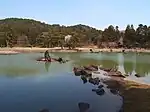

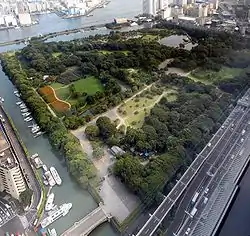
.JPG.webp)
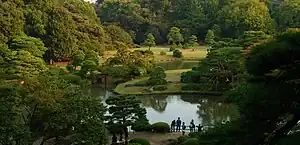

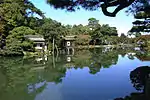




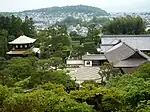
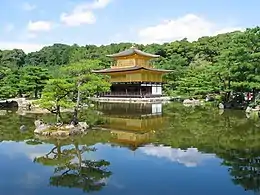

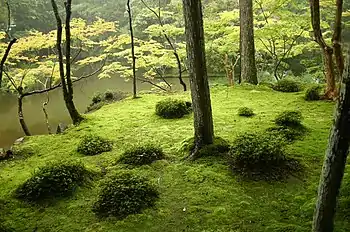
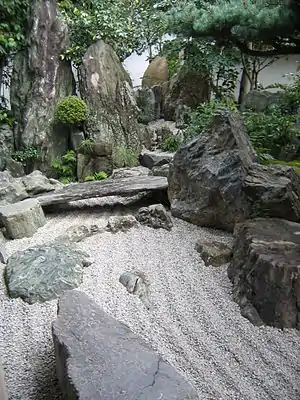
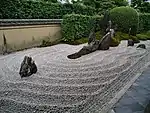
.jpg.webp)
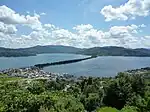

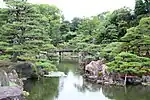

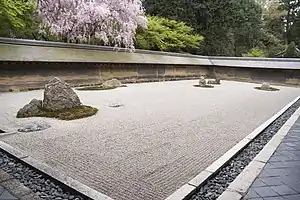
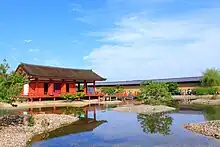
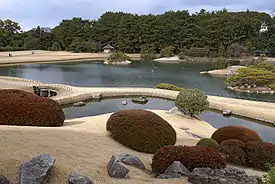
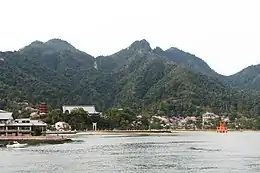
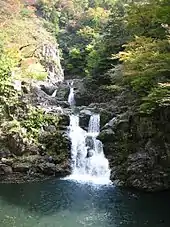
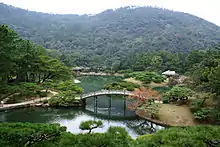
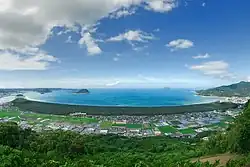

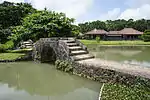
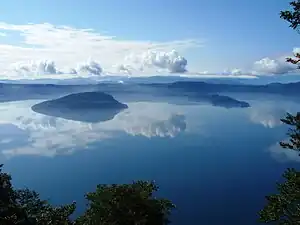
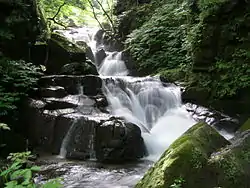
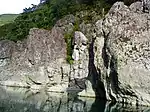
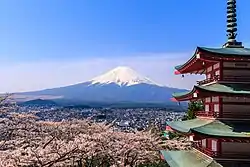

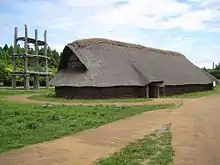
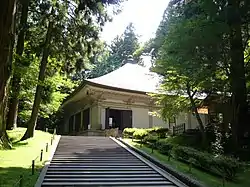
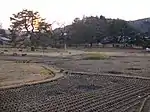
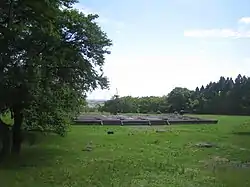
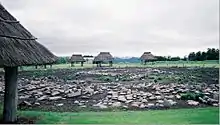
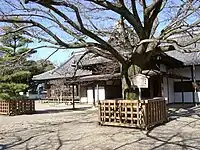
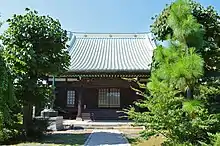
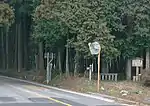

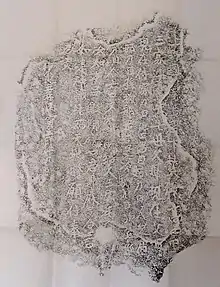
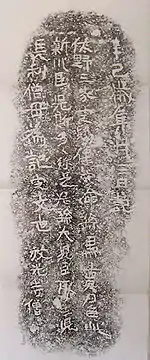
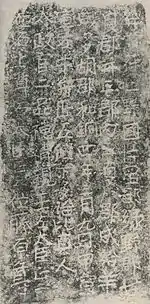

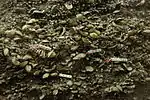

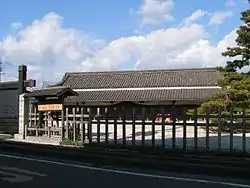
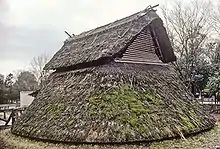
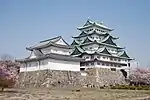

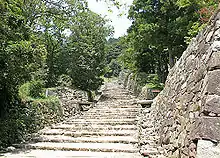
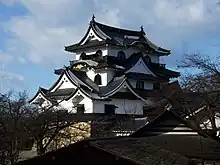
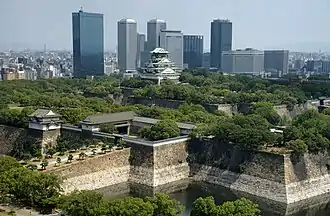
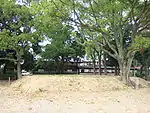
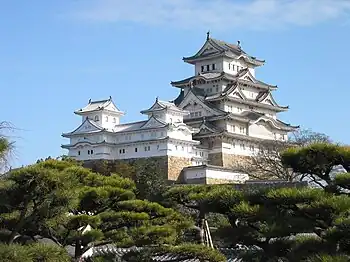

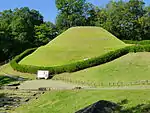

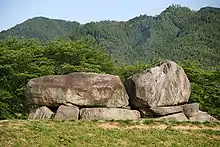
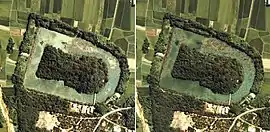
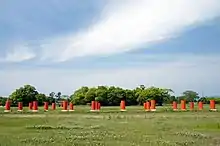

.JPG.webp)
